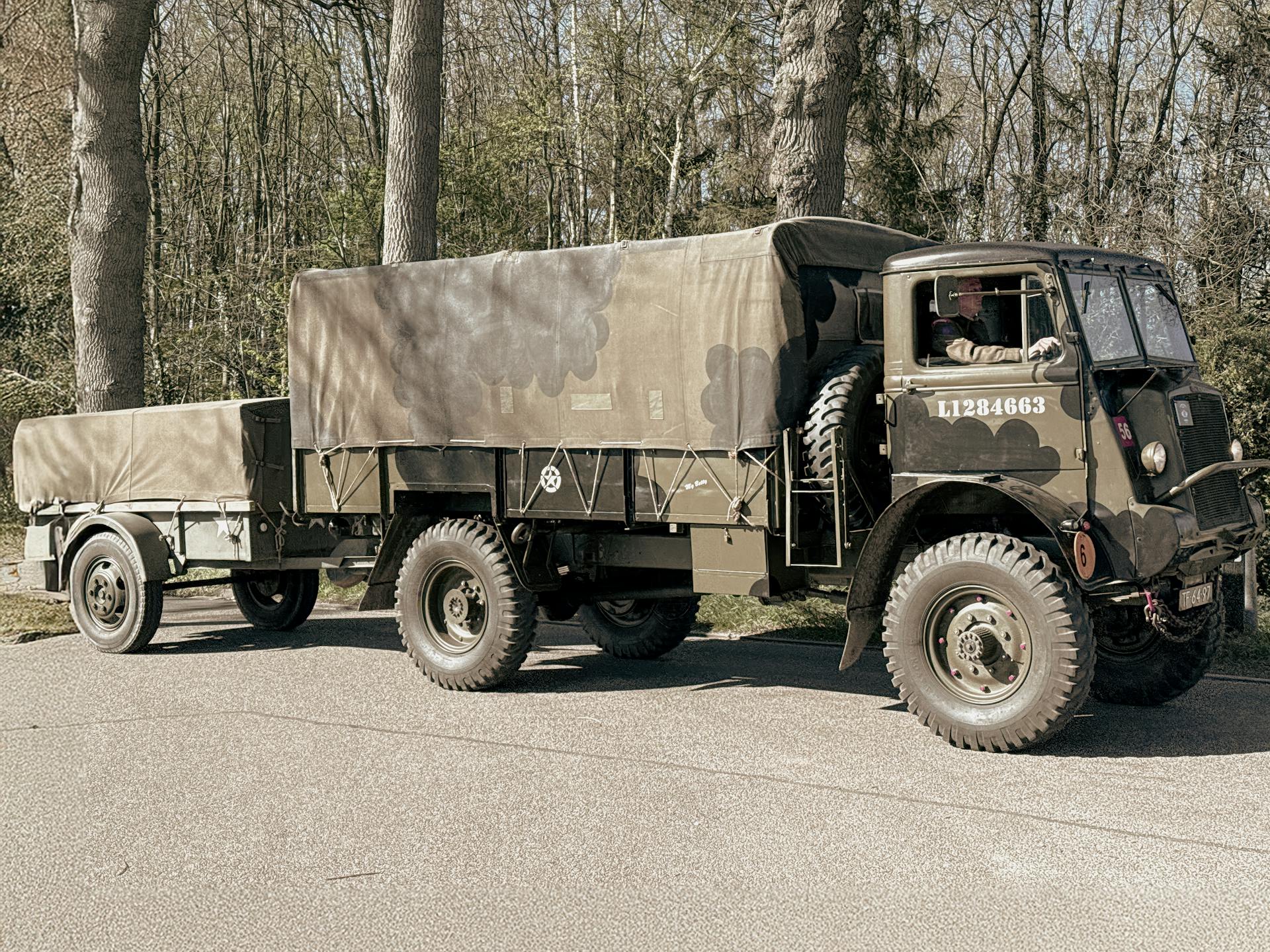
Oversize loads are typically defined as shipments that exceed standard dimensions, weighing over 80,000 pounds or measuring more than 8 feet wide.
To transport these oversized loads, specialized equipment is required, such as lowboy trailers or step-deck trailers, which can accommodate larger and heavier loads.
These oversized loads often require a permit, which is usually obtained from the state's department of transportation, and can take several days to process.
Permits can be issued for specific routes, and it's essential to follow the approved route to avoid fines or penalties.
For your interest: Oversized Pallets
Oversize Load Basics
Annually, 600 million tons of oversize loads hit the highways.
To transport an oversize load, you need a permit, which mentions the route to take, date, and time of travel.
About 5 million permits are granted each year.
A wide load truck that exceeds the maximum size or weight limit required for a truck on a specific road needs a permit to travel legally.
The permit prices are calculated based on state, dimension of the load, tons of weight, weight increments, or a combination of all the above.
Consider reading: Semi-trailer Truck
Regulations and Permits
To transport an oversize load, you'll need to obtain the right permits. The legal limits for a vehicle's size and weight are 80,000 pounds, 53' long, 13½' high, and 8½' wide.
Before applying for a permit, gather the necessary information, including your USDOT number, unit number, vehicle info, and load dimensions. You may need to provide additional details, such as the exact origin and destination, routes, and axle spacings.
In the United States, the maximum legal width is 8.5 ft, and the maximum height limit is 13' 6" from the ground to the top of the load. The maximum legal load length is 55 ft, but can vary by area and equipment type. If your load exceeds these measurements, you'll need an oversize permit.
Here's a list of the information you'll typically need to request an overweight or oversize permit:
- USDOT number/Federal ID number
- Unit number
- Vehicle info (year, make & model)
- Serial number
- License plate number and state
- Type (Flatbed, lowboy, drop deck, etc.)
- Number of axles
- Trailer length
- Load description
- Number of pieces and how they are loaded
- Load Dimensions (length, width, height and weight)
- Overall width (trailer or load – whichever is wider)
- Overall height (from ground to top of load)
- Overall length (truck + trailer and/or load – whichever is longer)
- Overall weight (truck + trailer + load)
- Individual axle weight when loaded (truck + trailer)
- Individual axle spacings (truck + trailer)
- Exact origin (address or junction, city & state)
- Exact destination (address or junction, city & state)
- Complete routes, including city streets, separated by state
Permits can be obtained online, via phone, or through a permit service, and may be required for oversize or overweight loads. The type of permit you need will depend on the specifics of your load and the routes you'll be taking.
United Kingdom

In the United Kingdom, an abnormal load is defined by its weight, width, and length.
If a load weighs more than 44 tonnes, it's considered abnormal.
A load is also abnormal if it has a single non-driving axle with a weight of over 10 tonnes or a single driving axle with a weight of over 11.5 tonnes.
Loads with a width of more than 2.9 metres or a rigid length of more than 18.65 metres are also classified as abnormal.
To transport an abnormal load in the UK, you'll need to notify the police, highway authorities, and any on-route bridge and structure owners, such as Network Rail.
National Highways operates a system called ESDAL to support these notifications.
A pilot car driver may temporarily block traffic at intersections to ensure the safe passage of the truck.
Additional reading: Abnormal Load Transport
Know Your Legal Boundaries
In the United States, the maximum legal width for a load is 8.5 ft. The maximum height limit is 13' 6" from the ground to the top of the load.

If your vehicle exceeds these numbers, you'll need an oversize permit. The maximum legal load length in most areas is 55 ft, but can vary by area and equipment type.
A load is considered oversize if it crosses the measurements mentioned above. You can't combine multiple pieces of freight to make a shipment over-dimensional or overweight.
Here are the key dimensions to keep in mind:
In some states, a load must be considered "nondivisible" to qualify for a permit. However, some states allow divisible loads to be granted permits.
If a vehicle is oversize or overweight, a temporary permit is needed. This permit authorizes movement according to vehicle configurations and weight.
Do You Have a Load?
A shipment can be considered oversized even if it's not exceeding the weight limit, but crossing the per-axle limits. You can adjust the truckload to make the shipment legal for transportation.
Weight restrictions are measured per axle as well as the total weight of the entire shipment. The most common measurement that causes shipments to be oversized is width. Anything wider than 8.5 feet is considered oversized.
It's crucial to check the width of your shipment before transporting it. This will help you avoid costly fines and delays.
Here's an interesting read: Texas Oversized Load Accident
We Simplify Permit Processes
We'll get the oversize permit you need in just an hour or two, making it easy to navigate the regulations and get back on the road.
The legal limits for a vehicle's size and weight are 80,000 pounds, 53' long, 13½' high, and 8½' wide. If your vehicle exceeds those numbers, it's likely overweight or hauling an oversize load.
You'll need to provide detailed information to request overweight or oversize permits, including your USDOT number, unit number, vehicle info, and load dimensions.
Some states may ask for additional information, so be sure to check with the relevant authorities to ensure you have everything you need.
Here's a list of the information you'll typically need to provide:
- USDOT number/Federal ID number
- Unit number
- Vehicle info (year, make & model)
- Serial number
- License plate number and state
- Type (Flatbed, lowboy, drop deck, etc.)
- Number of axles
- Trailer length
- Load description
- Number of pieces and how they are loaded
- Load Dimensions (length, width, height and weight)
- Overall width (trailer or load – whichever is wider)
- Overall height (from ground to top of load)
- Overall length (truck + trailer and/or load – whichever is longer)
- Overall weight (truck + trailer + load)
- Individual axle weight when loaded (truck + trailer)
- Individual axle spacings (truck + trailer)
- Exact origin (address or junction, city & state)
- Exact destination (address or junction, city & state)
- Complete routes, including city streets, separated by state
Shipping and Transportation
About 5 million permits are granted each year for oversize loads to travel on the road legally. These permits mention the route to be taken, date, and time of travel.
You probably have come across an oversize load a time or two when traveling. Annually, 600 million tons of oversize loads hit the highways.
To manage load distribution and vehicle weight, you need to know a few key items about your vehicle and its load. Make sure you take into consideration the empty weight of the vehicle, weight of the load, and the amount of weight your equipment can handle.
Here are some key items to consider for load distribution:
- The empty weight of the vehicle
- The weight of the load
- The amount of weight your equipment can handle
- Load configuration
- State axle requirements
To ensure proper weight distribution, it's essential to understand how to arrange the trailer axles, especially if your trailer has triaxle sets or split tandems that can handle more weight.
Additional reading: When Loading a Trailer If the Cargo
Hazards
Oversize loads can be a real hazard on roadways, posing a risk to both road traffic and the structures themselves.
These loads often exceed design clearances, making it possible for them to hit bridges and other overhead structures.
The I-5 Skagit River bridge collapse in 2013 was a prime example of this, caused by an over-height load striking the overhead beams.
Truss bridges are particularly vulnerable to over-height vehicle impacts, due to their critical support members being located over the roadway.
On a similar theme: Book Your Own Loads Trucking Companies
Tips for Managing Distribution
To manage distribution effectively, consider the empty weight of your vehicle, which can usually be found in the owner's manual. This is crucial for determining the maximum weight your vehicle can carry.
The weight of your load is also essential, and it's often listed on the paperwork accompanying the shipment. Make sure to check this carefully to avoid overloading your vehicle.
Understanding how to arrange the axles on your trailer is key to proper weight distribution. Some trailers have triaxle sets or split tandems that can handle more weight than others.
Load configuration is critical, and you need to plan it carefully based on the weight of your vehicle, the load, and the amount of weight your equipment can handle. This may involve rearranging the load to ensure even weight distribution.
State axle requirements can vary, so be sure to check each state's requirements before planning your route. This will help you avoid any potential issues or fines along the way.
Here are some key factors to consider when managing distribution:
- Empty weight of the vehicle
- Weight of the load
- Amount of weight your equipment can handle
- Load configuration
- State axle requirements
5 Key Considerations for Wide Load Shipping
Annually, 600 million tons of oversize loads hit the highways. You probably have come across an oversize load a time or two when traveling.
To ship an oversize load, you'll need a permit. About 5 million permits are granted each year. The permit mentions which route to be taken and what date and time the load is to travel.
The way permit prices are calculated for oversize loads can vary depending on state and by dimension of the load, tons of weight, weight increments, or a combination of all the above.
Oversize loads present a hazard to roadway structures as well as to road traffic. Because they exceed design clearances, there is a risk that such vehicles can hit bridges and other overhead structures.
Here are the different types of transportation permits:
To get a permit, you can visit the Caltrans Office of Commercial Vehicle Operations, located at 1120 N St., Sacramento, CA 95814, or call (916) 322-1297. Office hours are 8am-5pm, Monday through Friday.
Permit Types and Provisions

The legal limits for a vehicle's size and weight are 80,000 pounds, 53' long, 13½' high, and 8½' wide, but regulations vary by state. If you need to transport an oversize load, you'll likely need a special permit.
In California, for example, the Caltrans Office of Commercial Vehicle Operations issues special transportation permits for oversize/overweight vehicles on the State Highway System. You can order these permits online or through their 24/7 expert service.
Here are some common types of transportation permits in California:
Transportation Permit Types
Transportation Permit Types can be quite complex, but don't worry, I've got you covered. Caltrans has discretionary authority with respect to highways under its jurisdiction and may issue special permits for oversize/overweight vehicles.
There are several types of transportation permits, including Single Trip Permits for loads greater than 8'-6" wide, 14'-0" high, and over 80,000 pounds. Annual Permits allow loads up to 12'-0" wide, 14'-0" high, and Kingpin to Rear Axle (KPRA) 40'-0" maximum.
Intriguing read: Wide Load vs Oversize Load
Repetitive Permits are for loads up to 12'-0" wide, 14'-6" high, and 90'-0" long. Sea Container Permits are for 4-Axle tractors and 3-Axle trailers transporting intermodal cargo containers on state highways near the Port of Los Angeles and the Port of Long Beach.
Variance Permits are for vehicles greater than 15'-0" wide, 17'-0" high, and 135'-0" long, or on special hauling equipment which exceeds the Department's standard method of weight classification. Motorsport Permits are for vehicles going to an Automobile Competition Committee for the United States (ACCUS) sanctioned event at an authorized location.
Here are the different types of transportation permits:
General Permit Provisions
Permits often have specific requirements for the type of vehicle or load being transported.
You'll need to obtain a permit for each state you plan to travel through, even if it's just a brief stop.
Florida, Texas, and Georgia are popular states for oversize or overweight permits.
The permit process typically involves providing detailed information about your vehicle and load.
A different take: Oversized Load Permits
In Florida, you'll need to provide the weight and dimensions of your vehicle, as well as the type of cargo being transported.
Texas and Georgia also require detailed information about your vehicle and load, including the weight and dimensions.
Oversize or overweight permits usually have specific restrictions on the time of day and day of the week you can travel.
In Florida, you may be restricted from traveling during peak hours or on certain holidays.
Similarly, Texas and Georgia have their own set of restrictions on travel times.
Worth a look: Loading Dock Size
Frequently Asked Questions
What are oversize restrictions in VA?
In Virginia, oversize restrictions limit vehicles to 8'6" wide, 13'6" high, 65' long, and 80,000 pounds. Exceeding these limits requires a special permit.
What is the maximum oversize load?
The maximum oversize load is 112,500 pounds, which is the weight capacity of a five-axle configuration. This is the highest weight limit specified for the vehicle.
Sources
- https://en.wikipedia.org/wiki/Oversize_load
- https://www.kellerpermits.com/permits/overweight-oversize-permits
- https://www.r2logistics.com/5-considerations-wide-load-oversize-load/
- https://dot.ca.gov/programs/traffic-operations/transportation-permits
- https://www.udot.utah.gov/connect/business/motor-carriers/size-weight-permitting/oversize-overweight-provisions/
Featured Images: pexels.com


